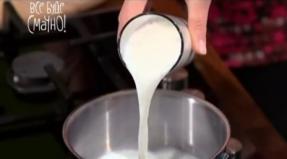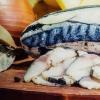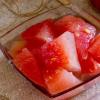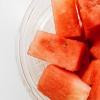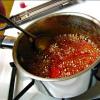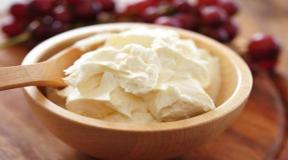Russian menu of the 19th century. For everyone and everything
Few people know that it makes no sense to talk about Russian cuisine. It just doesn't exist. Surprise! Many foreign gastronomic experts confirm this fact. However, like the one that neither French nor Italian cuisines exist. And the fact is that they are all created artificially. And they point only to the geographical boundaries of huge food cauldrons, in which hundreds and thousands of regional gastronomic features are brewed.
Gastronomic roots
We all tried Russian cuisine. Ah, these dishes with a bright, straightforward taste and an unchanging love for potatoes and dill! Modern domestic cooking with a tenacious grip became engaged to mayonnaise, and now they have love and complete understanding. All these dumplings, dumplings, pies, cereals and soups ...
Meanwhile, Russian cuisine is a gastronomic phantom over an almost endless country called Russia. A mixture of dozens of peoples and cultures formed a magic cocktail, in which we still brew. Only the Soviet Union was able to curb the free, abundant and interesting Russian cuisine, turning it into an obedient servant of the Ministry of Food Industry. The abundance of products and creativity of the chefs of Tsarist Russia was replaced by strict planning, redistribution and dry collections of recipes.
This is the legacy that modern Russia has received. An abundance of food, schools, technology and sources of influence. Although, under the strict guidance of French chefs, Russian cuisine acquired exquisite features. Just remember the original Olivier salad: crayfish tails, quail and no sausage. But the Germans gave us a love for minced meat dishes - sausages and cutlets.
Forgotten kitchen
And in 1785 in Russia the "Letter of Appreciation to the Cities" was issued. This is how the “third estate” appeared (after the nobility and the clergy), although it existed earlier, it flourished already in the 19th century. Soviet propaganda would have called them bourgeois, and history proudly names the merchants. With the development of commerce, this population group gained social weight. And the kitchen did not stand aside. It was on their initiative and needs that the restaurant business flourished throughout Russia. Thousands of taverns have merged into the urban landscape and have become an integral part of the lives of millions. This is how the merchant cuisine went to the masses.
Tyumen present
A special place in the merchant's cuisine was occupied by the rethinking of dishes and products from the past. This is how pike cutlets appeared. Once this predator was a terrible delicacy and was wildly popular among the boyars. Those, in large fur hats, fur coats and staffs. Yes, it was with them that Peter I himself chopped off his beards. And at the same time in England there was a similar hysteria among the aristocracy around the same fish. And now in Tyumen you can find pike cutlets, for example, in the restaurant "", here they are offered even in the format of a business lunch. The light sweetish taste of pike can please even notorious meat eaters.
Tyumen is a merchant city, although now there are also capital ambitions. But the past cannot be easily erased, once it was the merchants who determined the fate of the city. If you read the biographies of the heads of the city in the 19th century, then doubts about the role of the "third estate" in the life of Tyumen will melt by themselves. For a long time, the "" restaurant was a stronghold of merchant history. A colorful mansion in the most influential quarter. A creaking staircase. And small news from the past on the walls: money, postcards, photos with traces of history on the edges. And in the menu one could find several witnesses of the heyday of merchant gastronomy. But this has already become history.
Experiments have always been held in high esteem. It was once considered almost a gamble to change traditional recipes. And the dumplings differed in the molding method. But on the wave of merchant cuisine, hundreds of options for dumplings appeared, both in shape and in filling.So the Tyumen restaurant "" is not far behind, and its menu includes dumplings with fried mushrooms. True, these are not white, as Siberian logic suggests, but champignons, but thanks for trying to surprise. And a separate serving of broth from dumplings is also a find of the "third estate" cuisine.By the way, this "liquid wealth" can be easily found in the canteens of our city. I assure you, they are definitely there, and you can eat there too. On duty, I also go to public catering establishments ... and it seems like I'm alive and well. Sometimes you can find really interesting taste solutions in such places in the style of a real merchant cuisine. This is especially true for cereals and compotes. Cooked in large pots, infused and steamed well, they are of real gastronomic value.
Many merchants' fortunes were made on two whales: bread and tea. And what else does a Russian person need to be happy? Alcohol should not be offered ... Then it was not a manic passion of millions, but the lot of only a separate group of society. So tea creative, worthy of being called a merchant, is found in the restaurant "". Teas of a special collection: "Tsarskie", "Boyarskie", and, in fact, "Merchant zaboristy" with pink radiola, oregano, thyme and wild rose.
What is bread processed by merchants? What is a hamburger and hot dog for a Russian person rolled into one? These are pies. Small and large, hearty and dessert. This is the catering of the Tsar's era. Many small merchants started their business with him, selling pies for sale. Yes, with a tray around his neck, luring passers-by with loud calls. And in Tyumen for pies you can go to. A merchant classic looks like this - a pie with rabbit and mushrooms. Incidentally, a hit of the early twentieth century. And do not be afraid of the foreign name, but this is a pie. Remember the old Russian trade trick - to name a product or company with an unfamiliar word and preferably German? I think everyone has already guessed in what era this trick was invented. We have a lot to learn from them.
We are now living in an era of globalization. World cuisines have gotten as close as possible to our doorsteps. Already in my family, it became no surprise when my mother cooks lasagne, cheesecake or tiramisu. Although there is always room for cabbage soup with dumplings on the table. And the merchant's cuisine proved that it is not necessary to copy a foreign one in order to eat deliciously. You need to think, show resourcefulness and ingenuity. Maybe it's time for us to make modern Russian cuisine better?
Don't forget your roots and, of course, bon appetite!
Soup was an indispensable dish at the dinner table. Well, the main soup in Russia both then and now is cabbage soup. Take cabbage, beef, ham, a handful of oatmeal, onion, pour all of that with water and cook until deliberately stubborn. Then, having sprinkled a little flour with cow's butter on the same millet slurry in a special cup, put it in ashti and then whiten it with sour cream. ... When serving, add pepper and finely chopped onion and crackers. Cabbage soup in Russia is more than soup. Travelers took frozen cabbage soup in skating rinks with them on the road. Russian soldiers in foreign campaigns for lack of cabbage cooked cabbage soup from grape leaves. And sour cabbage soup is a drink more like kvass two centuries ago, even used to treat colds. At formal dinners, the soup was served by footmen. And in the estate, at the home table, the hostess herself poured the soup.
Either pies or kulebyaki were served with cabbage soup from fresh cabbage. Lunch at the estate was usually limited to four course changes. The soup was followed by a cold dish of your choice. Beads with cabbage, boiled pork with onions, beef studio with kvass, sour cream and horseradish. During the second break, fish dishes were often served. ... Fried, steam, salted, smoked, felted fish was included in the daily menu of a Russian nobleman. Fortunately, the Russian rivers and seas then abundantly supplied the lords' tables with salmon, sturgeon, salmon, beluzhin and sterlet. As a side dish, boiled crayfish were often attached to a fish dish. Caviar was not considered a special delicacy. The main thing in the fish was considered its freshness. As true gourmets of the 19th century argued, fish should be cooked when guests are already eating soup. Count Stroganov gave dinner to another famous hospice, Naryshkin. How the fire happened. Naryshkin alone was not taken aback and shouted: save the sterlet and the beluzhin.
The third change of dishes consisted of hot dishes: duck with mushrooms, a calf's head with prunes and raisins, Little Russian dumplings, brains under green peas. On the fourth break, they served mainly fried game: turkeys, ducks, geese, hazel grouses, partridges. For garnish: pickles, olives, pickled lemons and apples. ... However, along with the game, fried sturgeon with snails and a mutton side with buckwheat porridge could appear on the table. Listen, it sounds like poetry. And how can you refuse the hostess, who put another piece on your plate, another and another ...
As a matter of fact, there might not have been dinner at the estate. The process of eating food sometimes did not end until late in the evening. Dessert followed. Two types of cake were served at the table: wet and dry. To wet cakes belonged: compotes, cold jelly with cream, berry soufflé, biscuits and ice cream. These dishes were called wet cakes because they were eaten with spoons. Dry cakes were taken by hand, respectively. These are puff pies, marshmallows, pancakes, macaroons. ... And how can you resist these gastronomic temptations? Gluttony, although it is one of the biblical sins, but the Russian landowners were attached to it with pleasure. And there were gluttons and simply legendary. The fabulist Ivan Andreevich Krylov could swallow up to 30 pancakes with caviar in one sitting, eat three bowls of pasta, oysters at a time, he destroyed 80 pieces at a time, although doctors argued that a human stomach could not accept more than 50. In thousands and thousands of Russian estates, the day ended with evening tea. ... Drinking tea in Russian meant drinking it with food and sweets, and of course, with the invariably most beloved delicacy in Russia - jam. The number of jam varieties in cellars at the estate sometimes reached several dozen. For evening tea, you need to think about the preparations. After all, when winter comes, the gentlemen will have to move to the city, they will take with them a whole wagon train of various food, they will take with them everything that their estate is rich in, so that there will be enough food for the future.
150 g of beets, 30 g of horseradish, 20 g of 3% vinegar, 10 g of vegetable oil, 5 g of sugar, lemon zest, cinnamon, cloves, bay leaves and pepper.
Peel baked or boiled beets in the skins, chop them into strips or thin slices, put in layers in porcelain or earthenware dishes, sprinkle each layer with grated horseradish, pour chilled marinade and leave for 2-3 hours. Before serving, put the salad in a slide in a salad bowl, sprinkle with sugar and pour over with vegetable oil.
For the marinade, add cloves, cinnamon, lemon zest, bay leaves, peppercorns to the vinegar, bring to a boil in a sealed container, cool and strain.
60 g artichokes, 20 g celery (root), 30 g apples, 30 g tomatoes, 20 g vegetable oil, 1/4 lemon (for juice), 10 g lettuce, pepper.
Cut celery into strips, apples, fresh tomatoes (without skin and seeds) and boiled artichokes cut into small cubes. Mix vegetables, season with salt and pepper, add lemon juice and vegetable oil. Serve in a salad bowl, garnish with lettuce leaves.
For 500 g of potatoes: 1 onion, 1 pc. carrots, 1/2 clove of garlic, 1 glass of wine, 2 tablespoons of vegetable oil, 1/2 lemon juice, salt and pepper to taste.
The potatoes are boiled in their skins. Peeled carrots are boiled separately, cut into thin slices. Salt, pepper, finely chopped onion and a little crushed garlic are added to warm potatoes and carrots. A glass of wine is poured over this mixture and left for an hour, after which it is seasoned with a sauce made from lemon, 3% vinegar and vegetable oil.
For 150 g beans: 2 carrots, 1 large apple, parsley, 50 g dressing.
Cut raw carrots and peeled sweet apples into thin strips, combine with beans, add salad dressing and sprinkle with parsley. (For this salad, you can use both canned bean pods and fresh green beans by boiling, peeling and cutting into pieces).
For 100 g of dried mushrooms: 1 kg of beets, 2 onions, 1/2 cup of vegetable oil, 3-4 cloves of garlic, vinegar, sugar, salt.
Boil the beets in a peel, peel, cut into strips and sprinkle with vinegar. Finely chop one onion and simmer in vegetable oil. Cut the second onion and boiled mushrooms into strips. Crush the garlic. Mix all products, season with salt and sugar to taste.
For 50 g of salted mushrooms: 100 g of jelly (gelatin 4 g).
Garnish: 10 g carrots, 10 g pickles, 25 g potatoes, 3 g vegetable oil, 5 g vinegar.
To prepare the jelly, add a little brine squeezed from the mushrooms to the water, boil, put the gelatin soaked in water and dissolve it. Pour a thin layer of jelly into the molds. When it hardens, put finely chopped salted mushrooms, pour over the jelly and put in the cold. Remove the filling from the molds (dipping it into hot water for a few seconds), put it on a plate or vase, garnish with boiled finely chopped vegetables seasoned with vinegar, oil, pickles, etc.
Take boiled and peeled various dried mushrooms, pickled or pickled mushrooms. Cook separately in salted water until soft, peeled and chopped asparagus, chopped green beans, cauliflower and young potatoes, put in a colander, pour over with cold water, put in a cup, add slices of peeled fresh cucumbers, add 2 tablespoons of vegetable oil, a spoonful of vinegar, add chopped greens of tarragon, fennel, dill, stir, put on a dish in a heap, overlay circles of the same size on beets and potatoes, shifting them with bunches of green parsley. Take 600 g in total raw.
For a fish vinaigrette, you should always take large fish, in which there are few bones, such as: sturgeon, salmon, pike perch, whitefish, trout, etc.
Having cleaned the surface and the inside of the fish, you need to cut it lengthwise, remove the pulp first from the spinal bone, and then from the skin, remove, if possible, all small bones. To make it easier to take them out, cut these fillets into small slices, obliquely to the tail.
Then salt these slices, sprinkle with pepper, pour with lemon juice, put on a greased copper saucepan, add two spoons of cold water, cover with a lid so that the top layer of fish does not dry out, put in a cool oven or on the edge of the stove, so that the fish is both cooked and fried at the same time until cooked through.
When the fish is ready, put it out in the cold to cool down. When the fish has cooled down, put the chopped potatoes with beets on a platter, then fish in rows and slices of beautifully chopped potatoes and beets. Pour mustard sauce over each row, and for a more intricate table - Provencal sauce. When everything is laid, flatten, empty places can be filled with crayfish tails, top with Provencal sauce, flatten again, falling asleep with finely chopped herbs, put in the cold to make the sauce stronger.
| Vinaigrette from different meats |
100 g of meat or fish, 1-2 beets, 1 spoon of gherkins, 1 pickled or fresh cucumber, 1 herring, 2 eggs, 5-6 pcs. mushrooms, 1 spoonful of pickles, 5-6 potatoes, 2 tablespoons of capers, 3 tablespoons of sauerkraut, 1/2 cup of boiled beans, 20 olives, 1/2 cup of vinegar, 2 tablespoons of vegetable oil, 1 tablespoon of mustard.
Take different roasts: game, veal, beef or boiled fish: sturgeon, pike, salmon, add 1-2 boiled or baked beets, 1 spoonful of gherkins, 1 pickled or fresh large peeled cucumber, 1 herring, 2 hard eggs, 5-6 pickled mushrooms, 1 spoonful of pickles, boiled finely chopped potatoes - 5-6 pieces, 2 tablespoons of capers, 3 tablespoons of sauerkraut, 1/2 cup of white beans, olives, boiled in salted water, 20 pieces, boneless.
Cut all this into small rectangular pieces, add green parsley, salt, pepper, 1/2 cup of vinegar, 2 tablespoons of vegetable oil, 1 tablespoon of ready-made mustard - whoever loves, 2-3 pieces of sugar, stir, put on a dish, overlay with beautifully chopped cooked potatoes and beets, stick in a circle of green parsley, half slices of lemon, hard-boiled eggs.
| Leipzig vinaigrette |
200 g carrots, 200 g asparagus, 300 g green beans, 800 g green peas, 2 pcs. kohlrabi, 6 glasses of broth, 2.5 tablespoons of butter, 2 tablespoons of sugar, 2 tablespoons of salt, 2 tablespoons of flour, 3 yolks.
Leipzig vinaigrette is made from various vegetables: carrots, asparagus, cauliflower, green beans, green peas, kohlrabi, etc. After peeling carrots, they are quickly boiled in broth along with butter, sugar and salt. The peeled asparagus is cut into 2 cm pieces and boiled in water with salt, just like a cauliflower cut into small florets. Kohlrabi and green beans are cut into rectangular slices obliquely and cooked until soft in salt water, just like husked green peas. When all the vegetables are cooked, then they grind 2 tablespoons of oil with 2 tablespoons of flour to white, dilute them with as much water from asparagus and cauliflower, which is needed for the sauce, drive in 3 yolks, strongly beaten into a foam with a spoonful of sugar, and immediately remove the pan from the heat. On a round dish, place a large head of cauliflower in the middle and surround it with a wreath of beans, which ends with a wreath of carrots. Various vegetables, mixed with peeled crayfish, are laid out in a ray-like manner, and sauce is poured over everything. The different colors of the vegetables should be visible, so don't add too much sauce. The cooked dish is poured with crayfish oil, and beautiful small cutlets and stuffed crayfish shells are mixed around the dish.
Boil 500 g of potatoes, cut them into thin slices. 2 peeled and washed herrings, finely chop 2 onions; Grind 2-4 hard-boiled yolks until smooth with 2 tablespoons of vegetable oil, 2 teaspoons of prepared mustard, put pepper, 1 tablespoon of capers, a spoonful of vinegar, tarragon, stir with finely chopped potatoes.
75 g pressed caviar, 1/6 lemon, herbs.
Weigh the portions of caviar, place on a marble board and cut into a rectangle or rhombus with a knife. Carefully remove the caviar with the same knife, put on a dish or plate and decorate with herbs and lemon.
75 g balyk, 1/6 lemon, herbs.
Put the loaf, peeled and cut obliquely so that the pieces are wide, put on a dish or plate, put lemon and parsley on the side.
| Rcold jelly |
1-1.5 kg of heads, fins, skin of fish of the sturgeon family or the same amount of fish fines, 1 carrot, 1/2 onion, 2 parsley roots, 3-4 cloves of garlic, 1 teaspoon of gelatin.
Pour food waste or small fish into 1.5 liters of cold water and cook at low boil for about 2 hours. During the cooking process, periodically remove the resulting foam and fat. Half an hour before the end of cooking, add vegetables to the pan, and at the very end - spices.
When the fish is cooked, separate the flesh from the bones and chop finely with a knife. Strain the broth, add salt, fish pulp and boil for 10 minutes. If the broth is sticky enough, then no gelatin should be added. If this did not happen, then the gelatin is pre-soaked in water, added to the broth and brought to a boil. Put crushed garlic in the finished broth with pulp, stir the mixture, pour into prepared forms and leave to harden in a cool place.
On the bottom of the mold, you can put figured carrot slices.
100 g fish, 150 g jelly, 1/15 lemon, 40 g sauce, horseradish with vinegar, 100 g garnish.
Boiled and chilled sturgeon, stellate sturgeon or beluga, cut into pieces and stripped of cartilage and skin, put boiled or poached pike perch on a baking sheet so that there are gaps between the pieces, and pour a thin layer of jelly. Decorate the filled pieces of fish with slices of fresh cucumbers, figures from boiled carrots; you can also put slices of lemon, crayfish necks, sprigs of greens on the fish. To attach decorations to fish, you first need to dip them in melted jelly. When the jelly on the fish hardens, pour it again with a layer of 1-1.5 cm of jelly, cool and cut out portions of the fish so that the edges of the pieces are corrugated.
Serve the jellied fish with or without garnish. Serve the horseradish sauce with vinegar separately.
125 g sterlet, 150 g small fish, 3 g gelatin, 15 g pressed caviar, 15 g onion, 2 crayfish necks, 15 g granular caviar , 30 g sauce, horseradish with vinegar.
Cut the processed sterlet into portions and cook in pre-prepared fish broth from small fish. Remove the cartilage from the finished pieces of sterlet and store in the refrigerator. Strain the broth, bring to a boil, add soaked gelatin (12-15 g per 1 liter of broth) and clarify with a pull of caviar. Transparent strained jelly should resemble the ear in appearance and taste. Cool the jelly slightly and pour into a salad bowl in a layer of 1-1.5 cm. Put pieces of sterlet on the frozen layer of jelly, brown them with crayfish necks, granular caviar and gradually pour in the jelly.
When serving, the sterlet salad bowl can be placed in another bowl with crushed ice. Serve separately the horseradish sauce with vinegar. You can also cook pike perch, burbot or ruff.
120 g salmon, 100 g vegetable garnish in baskets, 50 g jelly, 1/15 lemon, 30 g mayonnaise, herbs.
Process small salmon or large trout so that the belly is not cut. Tie the prepared fish (as a whole with the head) in several places with narrow gauze ribbons, put the belly on the wire rack, tie in two places and set the wire rack in the fish kettle. Pour the fish with chilled spicy broth and slowly heat to a boil, then cook the fish at a temperature close to boiling. Cool the fish in the broth, remove the gauze, dry and remove the skin, cut the fish on both sides with a thin sharp knife, taking into account the number of servings. Decorate the fish with egg whites, parsley leaves, slices of olives or truffles, etc., attaching the garnish with jelly (dipping each garnish in jelly). After that, cover the fish with a paper tube with a thin layer of semi-solidified jelly and refrigerate.
Pour transparent strong jelly onto the dish (while taking into account the weight of the fish carcass) and, when it hardens, place the fish in the middle of the dish. Around the fish, make a narrow welt of finely chopped jelly using a paper tube. Garnish the fish with vegetables, herbs, puff baskets with chopped jelly. Stick the claws of large crayfish with lemon slices into the back of the fish. Serve mayonnaise sauce separately.
1 pig, 3 tablespoons of gelatin, 1 bunch of parsley, salt to taste.
For the sauce: 400 g sour cream, 100 g horseradish, salt and sugar to taste.
Wrap the scorched and well-washed piglet in a napkin, put in an enamel saucepan, add water so that it covers the piglet, put on high heat, let the water boil once, then reduce the heat so that the water does not boil. Thus, cook the piglet for 3.5 hours without salt, spices and roots. When the piglet is cooked, take it out, transfer it to another pan and fill it with salted cold water. From 1.5 liters of broth in which the pig was boiled, make jelly. Cut the cooled pig into portions: cut off the head along the joint, chop it in half lengthwise, cut the legs along the joint, chop the pig lengthwise, chop both halves into the same number of pieces. On a long platter, fold the pieces so that you get a whole pig, pour half-frozen jelly over it, decorating the pig with parsley sprigs. Serve horseradish sauce with sour cream with this dish.
1 hazel grouse, 4-5 pcs. potatoes, 2 fresh or pickled cucumbers, 100 g of green salad, 2 eggs, 1 tablespoon of vinegar, mayonnaise sauce.
The pulp of boiled or fried hazel grouse, potatoes, cucumbers, cut a hard-boiled egg into thin slices, cut the lettuce leaves into 2-3 pieces each, put it all in a bowl, salt and mix mayonnaise with the sauce, adding vinegar and 1/2 teaspoon of powdered sugar ...
Put the salad in a slide in a salad bowl, garnish with lettuce leaves and slices of hard-boiled eggs, as well as slices of tomatoes and fresh cucumbers.
50 g of ready-made poultry, 50 g of potatoes, 50 g of cucumbers, 30 g of green beans or peas, 1 egg, 50 g of mayonnaise, 10 g of tomato sauce, herbs.
Boiled potatoes, cucumbers and tomatoes (fresh or canned) cut into thin slices, green beans into slices, chop the lettuce, cut the flesh of smoked poultry into thin slices. Season some of the prepared vegetables and herbs with sauce, mayonnaise, add tomato sauce and put in a salad bowl in a slide; put slices of poultry on top, cut the remaining vegetables and boiled eggs into slices and put around the slide.
Before serving, pour the salad with mayonnaise from a paper tube, decorate with herbs.
60 g cooked game, 35 g potatoes, 30 g fresh cucumbers, 25 g cauliflower, 30 g tomatoes, 10 g celery, 15 g beans (pods), 25 g green peas, 25 g asparagus, 40 g salad dressing, 15 g green salad.
Cut boiled or fried game (hazel grouse, pheasant, black grouse, partridge) into thin oblong slices, boiled potatoes and carrots - in slices 1.5-2 cm in diameter, boiled asparagus and green beans - in slices 2.5-3 cm, Divide the boiled cauliflower into small coles. Use canned peas. Cut the salad celery into thin strips, fresh tomatoes and cucumbers into circles.
Put finely chopped salad in the center of a salad bowl or vase, and around - vegetables in piles, then slices of game in a pyramid; Arrange celery branches or lettuce leaves in the middle.
When serving, sprinkle with salad dressing or serve separately.
1/2 hazel grouse or partridge, 50 g of mayonnaise with jelly, 1.5 gelatin, 150 g of a garnish of vegetables, prunes and herbs, 20 g of salad dressing, 1/4 of an egg.
Let the hazel grouses or partridges simmer, cool, remove the fillets from the bones, peel and trim. Separate the small fillet, cut it slightly obliquely in two or three places with a sharp knife and insert into the slots 1.5 cm semicircular slices of egg white, tongue or ham and pour the meat jelly. Top the large game fillet with mayonnaise and jelly sauce. Decorate with a pattern of vegetables, prunes, etc. Top with semi-hardened jelly for gloss with a spoon.
When serving on the mixture of vegetables, put a large fillet covered with mayonnaise, and next to it a small fillet filled with jelly.
| I AMeggs in crab baskets |
1 egg, 35 g canned crabs or crayfish necks, 25 g mayonnaise, 10 g granular caviar, 1 puff pastry basket, herbs.
Boil eggs in a bag, cool. Place eggs in puff or unleavened pastry baskets filled with crabs dressed with mayonnaise sauce. Release granular caviar (in the form of a lace) from the paper tube around. When serving, place the baskets on a dish covered with a paper napkin, garnish with sprigs of parsley or celery.
2 eggs, 2 oxen or 1 large, 80 g fish, 50 g sauce, 10 g wine, 1/10 lemon, 5 g flour, 10 g mushrooms, 50 g crab or crayfish necks, 10 g butter, pepper.
Cut sturgeon, stellate sturgeon, beluga without skin and cartilage into small slices (7-10 g each), scald in boiling water and simmer in a sealed container with fish broth and dry white wine. Transfer the finished fish to another dish, and evaporate the remaining broth by half the volume, then pour white or tomato sauce into it, boil, season with butter, lemon juice, salt and pepper. Put in this sauce steamed fish, boiled fresh champignons or porcini mushrooms, cut into thin slices and warm everything up to 80-85 ° С. pieces in the form of cubes about 1.5 cm in size, season with salt, breaded in flour and lightly fry in butter.
Pour the fried fish with white or tomato sauce, seasoned with butter, salt and pepper, add boiled fresh champignons or porcini mushrooms cut into thin slices. After that, bring the fish to a low boil until fully cooked.
Cut the prepared crabs or crayfish necks into small pieces, heat with butter and season with tomato sauce.
With this or that fish or crabs, prepared as described, fill volovanov from unleavened puff pastry, place on them an egg boiled in a bag, pour over with thick tomato sauce, if the fish was seasoned with white sauce, then use hollandaise or crayfish sauces. Decorate the dish with crayfish tails and champignon slices.
800 g buckwheat flour, 500 g wheat flour, 1 l milk, 0.5 l cream, 200 g sour cream, 100 g butter, 5 eggs, a tablespoon of salt, a tablespoon of sugar, yeast.
Boil half of the prescribed norm of milk, cool it so that it is slightly warm. Yeast is dissolved in a small amount of this milk, it is poured into the rest of the milk, gradually all the buckwheat flour is added, stirring well. Dough is placed in a warm place for 1-2 hours. Add the rest of the milk, cream, put the yolks, pounded with sour cream, sugar, butter and salt, and gradually add wheat flour. The dough is kneaded and allowed to rise for 1.5-2 hours. Then whipped egg whites are added.
These pancakes were very common in the old days. A variety of products were used as a bake (filling): chopped eggs, mushrooms, liver, fish and others.
You can bake these pancakes in different ways, depending on the hearth. The easiest way is as follows: less dough is poured into a preheated greased pan than usual. When the pancake is slightly browned from below, they put the heat on it, fill it with a new portion of the dough so that the heat is inside. Then the pancake is turned over to the other side and lightly fried.
Pastry can also be put directly on a preheated pan, and then pour the dough on top. If the pancakes are baked in a Russian oven, then it is better to bake them open on the unfried side of the pancake.
You can include a variety of vegetables as a filling in pancake dough. This is not only tasty, but also very healthy, since the dish is made more balanced in composition and less high in calories. The method of preparing pancakes with various vegetable additives practically does not differ from those described. Such pancakes are especially useful for children and the elderly.
200 g buckwheat flour, 200 g wheat flour, 3 cups of milk, a full dessert spoon of soda, 3 eggs, a full dessert spoon of cremortartar (peeled tartar), 2 tablespoons of water, a spoonful of butter.
Preparation: 200 g of buckwheat flour and 200 g of wheat flour are stirred in 3 glasses of cold milk, adding a little of it; then add 3 very loose eggs and, shortly before baking, put a full dessert spoon of cremortartar and a full dessert spoon of soda, dissolved in 2 tablespoons of water. From the prepared dough, small pancakes are baked in oil or fat and served with melted butter and sour cream.
400 g of buckwheat flour, 400 g of wheat flour, 4.5-5 glasses of water, 2 teaspoons of salt, 2 teaspoons of sugar, 1 teaspoon of citric acid, 1 teaspoon of soda, 100-200 g of butter.
Take 400 g of buckwheat and 400 g of wheat flour, 4.5 - 5 glasses of warm water, add salt, sugar, mix well, beat out. When the pans are hot, take 1 teaspoon of acid, pour it into 0.5 cups of cold water, stir, pour into the dough, then stir 1 teaspoon of baking soda in 0.5 cups of cold water, pour into the dough, stir and bake immediately pancakes.
Serve melted butter, sour cream, caviar to the pancakes.
4 cups buckwheat flour, 2.5 cups water, 2 cups milk, 20-25 g yeast, 1 teaspoon sugar, salt to taste.
These pancakes are called custard pancakes because flour or dough is brewed with boiling water. You need to use not boiling water, but only heated to a boil. The liquid should be poured gradually (in a trickle) so as not to kill the yeast.
Pour two glasses of flour into a saucepan, pour two glasses of boiling water over it, stir well so that there are no lumps. When the dough has cooled to room temperature, dilute the yeast in half a glass of warm water and pour it into the dough. Beat the dough well, cover with a towel and put in a warm place. When the dough increases in volume 2-3 times, add flour, milk, salt to it, beat again and put in a warm place. Bake pancakes in the usual way.
800 g wheat flour, 8 eggs, 100 g butter.
800 g of wheat flour, 8 egg yolks and 100 g of butter, put in a saucepan and, after stirring thoroughly with a jelly, dilute with sour milk to the proper proportion, then knock down 8 proteins, put in the dough and, mixing the whole mass with merry, bake pancakes.
10 sweet and sour apples, 1.6 kg of wheat flour, 15 g of dry yeast, 10 eggs, cream.
Apples are mashed or apples are baked in the oven, and then rubbed through a sieve. From 800 g of flour, make a dough in milk; when it cools, add yeast diluted in a little milk and put in a warm place to rise. When the dough rises, add the applesauce, another 800 g of flour, 10 yolks and 10 whipped whites, beat well, dilute with cream until ordinary pancakes are thick, allow to come up again and bake.
Sugar, jam and cream are served separately.
She was very popular among the merchants. It was often served in taverns. Kulebyaki differ from pies by their elongated shape and complex filling.
For the dough: 400 g flour, 25-30 g yeast, 1.5 glasses of milk, 100 g butter, 1-2 eggs, a pinch of salt, sugar to taste.
For minced fish: 400 g of pike fillet (or other fish), 1 tablespoon of vegetable oil, 2 eggs, 2 tablespoons of crushed crackers, 1 tablespoon of sour cream, 1/3 cup of milk, 1 onion, salt, pepper to taste.
For the rice filling: 200 g of rice, 2.5 cups of water, 1 tablespoon of oil, 1 teaspoon of salt.
In addition, you need 300 g of fillets of any oily fish, egg yolk for lubrication.
Prepare the yeast dough in a sponge way, While the dough is coming up, cook the rice porridge. After the porridge has cooled, put it in a greased frying pan and bake in the oven until the porridge is slightly browned.
Scroll the pike fillet twice with the onions through a meat grinder and, adding finely chopped boiled eggs, as well as other components, mix the minced meat well.
When the dough comes up, roll it out into a finger-thick oval cake. In the center of it with an oblong slide, lay the layers of minced fish and rice, then pieces of fish fillet and again minced meat and rice.
Wrap the edges of the flatbread and pinch tightly over the minced meat. Decorate the surface of the cake with pastry elements. Place prepared kulebyaka for proofing in a warm place for 15-20 minutes. Then you should grease it with egg yolk and make several punctures with a fork. This is necessary for the steam to escape during baking.
The oven temperature should be 210-220 ° C. The baking time of the cake depends on the thickness of the dough and the type of minced meat. The readiness of the kulebyaki can be determined by piercing it with a thin wooden stick or a match: if the dough does not stick to the stick, then the pie is ready.
| Rasstagay |
Pie is a round baked product with an open filling in the middle. Outwardly, it is a pie, pinched in such a way that a hole and an open filling remain on top. Pies were served constantly in taverns.
400 g of flour, 3 tablespoons of oil, 25-30 g of yeast, 300 g of pike fillet, 300 g of salmon (pike and salmon can be replaced with other fish, so good minced meat is obtained from sea bass, cod, pike perch, carp), 2- 3 pinches of ground black pepper, 3 eggs, a spoonful of crushed bread crumbs, 1.25 cups of milk, salt to taste.
Dissolve yeast in warm milk, add flour and knead the dough. Let it rise, then put 2 yolks, 2 tablespoons of butter in it and, beating well, let the dough rise again.
Finely chop the pike fillet and, season with salt and pepper, fry in oil.
Roll out the dough that has risen a second time into a thin sheet and cut circles out of it with a glass or a cup. Put minced pike meat on each circle, and on it a thin piece of salmon. Pin the ends of the patties so that the middle remains open.
Place the prepared pies on a greased baking sheet and let them stand for 10-15 minutes. Then grease each pie with an egg and sprinkle with breadcrumbs. Pies should be baked in an oven preheated to a temperature of 210-220 ° C.
| Rastegay moscow with meat and egg |
For minced meat: 800 g of meat (pulp), 3 tablespoons of margarine, 5 hard-boiled eggs, salt, ground black pepper to taste.
Prepare a regular yeast dough. Cut the meat into small pieces and mince or chop with a knife. Put the chopped meat on a baking sheet (or frying pan), greased with margarine, stew a little, then mince (or chop) again, add salt, pepper, chopped eggs to it.
From the dough, make balls, each weighing about 150 g, and let them stand for 8-10 minutes. Roll out round cakes from these balls, put the filling (70-80 g) on them and pinch the edges, leaving the middle open. Leave the pies for 10-15 minutes on a baking sheet greased with margarine. Bake the pies at a temperature of 210-220 ° C. After baking, grease them with butter.
For the filling: 500 g of fish fillets, 1 onion, 2-3 potatoes, 2-3 tablespoons of butter, salt, pepper to taste, 2 eggs for lubrication.
Prepare yeast dough in a sponge way. Roll it out as you would for a regular pie and form two round or rectangular cakes. The cake that will be used for the bottom layer of the cake should be slightly thinner than the top one.
Place the filling on the tortilla: a layer of thinly sliced raw potatoes, sprinkled with salt and pepper, large pieces of fish fillet, on top - thinly sliced raw onions. Sprinkle everything with oil and cover with a second cake. Join the edges of the cakes and bend them down. Allow the dough to distance, brush it with an egg and make several punctures with a fork. Bake in an oven preheated to a temperature of 200-220 ° C. Instead of raw potatoes, you can use mashed potatoes prepared with the addition of fried onions, milk, cream.
For the dough: 25 g of yeast, 400 g of flour, one and a half glasses of milk, a quarter spoon of salt, 100 g of butter, an egg, a spoonful of crushed crackers.
For minced meat: a plate of roast leftovers, a cup of roast sauce, a spoonful of butter, a spoonful of sour cream.
For the rice filling: 100 g of rice, 4.5 cups of water, half a spoonful of oil, 5 eggs, a teaspoon of salt.
Prepare yeast dough, knead well and let it rise. After rubbing 100 g of butter into a foam, put it in a well-risen dough and give the dough, if there is time, rise again. Then, adding a little flour, knead the dough and, having rolled out a part of the dough as thick as a finger, put it on a sheet smeared with butter; a layer of minced meat (prepared from the remains of the roast, oil, sour cream and sauce from the roast) is spread on the dough, then hard-boiled coarsely chopped eggs, rice and eggs again (washed rice is boiled in 4.5 glasses of water with the addition of salt and half a spoon butter; it must not be placed hot on the dough). Having rolled out the rest of the dough, close the filling and, pinching well on all sides, let it rise again. After that, grease with an egg, sprinkle with breadcrumbs and bake for about an hour in a fairly hot oven. The pie is served hot.
400-600 g of cabbage, 1/3 cup of vegetable oil, 5 grains of allspice, 1 onion, 600-800 g of fish, 5 grains of black pepper.
Fry 1 finely chopped onion in 1/4 cup oil, put 3 cups squeezed sauerkraut, small peppers and paprika, simmer under the lid until soft, stirring so that it does not burn. Peeled salted fish: salmon, salmon, sturgeon, etc., cut into thin slices, remove the bones from it, fry in a spoonful of oil, mix with cabbage, fill the pie.
For the first filling: 3 tablespoons of rice, 150 g of fresh mushrooms, 4 tablespoons of butter, 3 glasses of water for cooking rice, 1 onion, 1 teaspoon of wheat flour, salt, pepper to taste.
For the second filling: 700 g of fresh cabbage, 2 eggs, 4 tablespoons of butter, salt to taste.
Prepare yeast dough, roll it out in a wide thin layer and cut out circles with a diameter of 60-70 mm. Prepare the fillings.
For the first filling, boil rice, boil mushrooms in salted water until tender, mince and fry in oil with onions. Put the mushrooms out of the pan, fry the flour on it, dilute it with mushroom broth (1/2 cup). Combine this sauce with mushrooms and rice.
For the second filling, rinse the cabbage and cut the stump out of it. Then chop the head of cabbage and fry in a pan with butter until soft. Add chopped boiled eggs to the cabbage, salt and mix everything.
Put the minced meat in the middle of each circle (cakes), fold the cake in half and pinch with a pie. In this case, the pies should be with different minced meat. Put a layer of pies in a greased wide and deep enough form, grease them with oil. Put a new layer on them, etc., until the form is filled to the top. Grease the top layer of pies with butter, put the dish in the oven and bake at a temperature of 200-220 ° C.
When serving, this pie is not cut, but disassembled with a fork, spoon and knife.
| NSIrog honey |
For the filling: 1 glass of honey, 200 g of butter, 1 glass of nuts, 3 eggs (of which one is for lubrication).
Prepare yeast dough or bezoparny dough, roll out a round or rectangular cake from it, put it in a greased frying pan.
From the same dough, make a tourniquet, which is placed on a baking sheet along the edges of the pie. This rim is designed to prevent the honey filling from dripping onto the baking sheet.
Prepare the filling: heat the honey and butter to a liquid state, cool to 25-30 ° C, add chopped nuts and eggs and mix everything. Lay this filling evenly on the surface of the pie and after 20-30 minutes of proofing, grease the rim with an egg and bake in the oven at a temperature of 210-220 ° C.
300 g of beef pulp, 300 g of pork pulp, 1 onion, 2-3 cloves of garlic, 2/3 cup milk, salt, pepper to taste.
Skip the beef, pork, onion and garlic through a meat grinder, season with salt, pepper, add milk and stir the minced meat well until fluffy.
Make dough and make dumplings.
100 g of dry mushrooms, 400 g of any fish fillet (preferably sturgeon, salmon, halibut), 2 onions, 1/2 cup of vegetable oil, salt, pepper to taste.
Rinse the mushrooms well, add water so that it covers them by 2 fingers, and cook until soft. Pass fish fillets, mushrooms, onions through a meat grinder, mix everything well and fry until tender in a pan with butter.
300-350 g of pork pulp, 200 g of fresh cabbage, 1/4 cup of water, 1 onion, salt, pepper to taste.
Pass the pork pulp and onion through a meat grinder, add finely chopped cabbage, salt, pepper, water and mix well.
Next, cook the dumplings in the usual way.
250 g of pork pulp, 300 g of fish fillets (pink salmon, chum salmon), 2 onions, 1 egg, 1/4 cup of water, salt and pepper to taste.
Fish, pork and onion mince twice. Add egg, pepper, salt, water and mix well.
Next, cook the dumplings in the usual way.
Started! As in the forests near Moscow, after the rains, noble mushrooms begin to appear, so in Moscow, one after another, restaurants of Russian cuisine are opening, or the old ones are updating their menu.
Zamoskvorechye is a symbol of merchant Moscow.
A restaurant in Zamoskvorechye has updated its menu this week Nicholas, now it's a restaurant merchant Moscow cuisine... What is here is not surprising to me. For me, specifically, Zamoskvorechye was a symbol of patriarchal Moscow.
I understand that division into petty bourgeois, merchant, noble, peasant and other cuisines are very arbitrary, but there are still differences. If the nobility or landowners in the 19th century were more susceptible to French influence, then the Moscow merchant retained to a greater extent the tastes and technologies of past centuries. Merchants are respectable people, committed to traditions and do not exchange for cheap French trends. And the portions should be large.
Chef and historians
In front of the restaurant chef Vladimir Gorskikh and historians of Russian cuisine Paul and Olga Syutkin there was a difficult task - to select old recipes that would correspond exactly  merchant cuisine and put them in a modern way, or rather taste.
merchant cuisine and put them in a modern way, or rather taste.
A restaurant is a commercial establishment that should be profitable. The menu of any institution should include dishes that are ordered, that is, they make a profit, so from the many ancient dishes it was necessary to choose the dishes that would be sold.
As I was told Olga Syutkina, it was interesting and difficult. Not all 19th century technologies can be replicated in modern kitchens. Tastes have changed long ago. And if 150-200 years ago, our ancestors did without sauces, as such, then for today's eater, serve your sauce with each piece of meat or cutlet. But there were almost no sauces as such in traditional cuisine, without French influence, there were boils, a little different from the sauces we are accustomed to. Or buckwheat, now we know two types of perforated and unground, and in the 19th century there were much more of them, for example, smolensk grain... And buckwheat acquired a brown appearance after roasting in the middle of the 20th century.
Food. Snacks
 I will say right away that buckwheat is found in many dishes, which is not surprising - a national product. For example, baked pig with buckwheat.
I will say right away that buckwheat is found in many dishes, which is not surprising - a national product. For example, baked pig with buckwheat.
We all represent the whole pig at once. But this is wasteful, both for the 19th century and for the 21st century. Yes, the company can order a suckling pig stuffed with buckwheat, or it can be cooked like in Nicholas.
Note to hostesses:
To make a pig with buckwheat, it is not necessary to take it whole, you can do with a piece of pork.
 What you see in the photo is very similar to modern Olivier, but in the 19th century this salad was called “ mayonnaise» ( one of these days it will be necessary to tell the story of the salad "olivier" - "mayonnaise" in Russia). So salads - the predecessors of modern Olivier, metropolitan and other mayonnaise salads were in the 19th century. A sort of grandfather. Suddenly!
What you see in the photo is very similar to modern Olivier, but in the 19th century this salad was called “ mayonnaise» ( one of these days it will be necessary to tell the story of the salad "olivier" - "mayonnaise" in Russia). So salads - the predecessors of modern Olivier, metropolitan and other mayonnaise salads were in the 19th century. A sort of grandfather. Suddenly!
The classic Russian salad has its own history. the vinaigrette... I've always wondered why we have it a salad, but in France it is a sauce, and not only for salads. Wait - I'll write one of these days .
Jelly or jellied meat - this dispute is perennial, both among philologists and among cooks. I will not throw in more logs, and I will name it as in the menu - jelly.  Here he is with pig ears.
Here he is with pig ears.
Pavel Syutkin explains : Initially, jelly was a dish for the disposal of leftovers from butchering meat. Hooves, ears, entrails - this is the basis of this dish, due to collagen it solidified. At the same time, the broth was dark opaque, it was later they began to lighten it, cut vegetables figuratively, add an egg, sprigs of herbs, and later they generally began to make aspic in a light broth with the addition of gelatin. But in the 19th century it was a dark, opaque dish, I will say it - "fatty". Jelly in Nikolos is the chef's vision of a dish of Russian merchant cuisine of the century before last.
Soups
Soups, in such a form and in such quantity as they are present in Russian cuisine, in the 19th and 21st centuries, are nowhere to be found anywhere else.
Naturally, there is a presentation of cabbage soup and borscht.
Borscht and cabbage soup appeared much earlier than on the territory of the former Russian Empire or the USSR, as you like, the first states were formed.
 I will note Sauerkraut soup with buckwheat... Cabbage soup itself is tasty, but special attention to buckwheat - buckwheat casseroles. It can be eaten as a bite or dropped into a pot. I didn't understand how tastier it was.
I will note Sauerkraut soup with buckwheat... Cabbage soup itself is tasty, but special attention to buckwheat - buckwheat casseroles. It can be eaten as a bite or dropped into a pot. I didn't understand how tastier it was.
Again, a little history. The closer to spring, the more and more the cabbage was fermented and in order to soften the acid in the soup, buckwheat was added to it. Buckwheat, like most cereals, will reduce the acidity in the dish. Did not know? And I didn't know.
Hot
In this section of merchant cuisine, you will not find a riot of colors and tastes, as if it were a noble cuisine with a French bias. Here all the dishes have come to us from time immemorial.
Boiled beef- Russian base but French influence and it is served with béchamel sauce and potato gratin.
Pleased with the pike perch under the buckwheat crust. But even here you can see France - asparagus and bechamel.
One more advice to housewives:
Try to replace bread crumbs with buckwheat in your dish, it will be healthier and tastier
You can talk as much as you like about the originality of Russian cuisine, but the 19th century was the time when the French had a very strong influence on Russian cuisine. It seems to me that borrowing, if it brings something new and useful, is not so scary.
Interior.
 Usually guests' first impression of a restaurant is the setting. Here it matches the new menu.
Usually guests' first impression of a restaurant is the setting. Here it matches the new menu.
The feeling that you were transported 150 years ago, transported only in time, but not in space, this building stood here in the middle of the 19th century.
As if nothing had changed during this time, the same chairs, tables and flowers in vases.
Summary
 I realized that the Moscow merchant cuisine is somewhat not mine, here, excuse me, the taste and color - you can't get enough forks.
I realized that the Moscow merchant cuisine is somewhat not mine, here, excuse me, the taste and color - you can't get enough forks.
The prices are somewhat high. There is a reasonable explanation for this - all products are farm products, from their own farm, the cost is high.
But it's worth going to understand how our ancestors ate. Perhaps I wanted "something like that", while others will like it.
In any case, everything is solid, natural, and the portions are large, as Russian merchants of the 19th century would have liked.
Alexander Pushkin was a famous connoisseur of delicious snacks and drinks. His hero Eugene Onegin also entered the history of literature as a gourmet. In the novel, in verse, the poet mentioned more than 30 different dishes, many of which not even every aristocrat could afford. We remember what the secular lions of the early 19th century loved to eat, including the dandy Eugene Onegin.
IN PETERSBURG
After the morning toilet and lazy reading of invitations to balls and evenings, Onegin went for a walk. At about four o'clock in the afternoon it was time for dinner. This time was considered "European" for dinner - in winter at four o'clock it is already dark. Unmarried young people living in the city rarely hired a cook - a serf or a foreigner. Therefore, they went to restaurants for lunch.
In terms of gastronomy, the nobles were guided by European and especially French cuisine - a recognized trendsetter in culinary fashion. It is not surprising that Eugene Onegin went to the French restaurant Talon for lunch.
The institution really existed in St. Petersburg. Dandies of that era gathered in the restaurant of the Frenchman Pierre Talon in the house number 15 on Nevsky Prospekt. His chefs fed the secular lions until 1825.
Alexander Pushkin himself often visited this fashionable place. The restaurant was not only one of the most popular, but also one of the most expensive in St. Petersburg at the beginning of the 19th century.
Entered: and a cork in the ceiling,
The comet's guilt splashed the current ...
Here, of course, Pushkin wrote about champagne - a familiar drink of the Russian aristocracy of that era. The poet was referring to the champagne of 1811. After a sultry and dry summer that year, a mild and warm autumn came to Central Europe. The grape harvest was unusually good, and the wine from it turned out to be simply excellent. Then in August, a bright and large comet appeared in the sky, which was also observed by the inhabitants of St. Petersburg.
This year's champagne was corked with a comet. The rare wine was highly regarded by connoisseurs for its taste. Because of the war between Russia and France in 1813, only 100 bottles of champagne of the 1811 harvest were officially imported into Russia - for 600 rubles.
"Before him roast-beef bloody ..."
In 1819-1820, the fashion for the English dish roast beef came to Russia. It was made from good bovine tenderloin. To keep the fillet tender inside, it was kept in milk for several hours before cooking. After that, they were fried for three minutes on each side in a pan, poured with dry white wine and cooked for another 15 minutes.
The center of the meat was supposed to remain half-baked - bright pink in color. From above, the dish was covered with an appetizing golden brown crust. Roast beef was usually eaten cold. The meat juice was drained and served in a gravy boat. Roast beef was served with fried potatoes or baked vegetables.
And truffles, the luxury of a young age,
French cuisine is the best color ...
Truffles are another product that only wealthy nobles could afford. The famous French chef Jean Anthelm Brillat-Savarena called expensive fragrant mushrooms “the diamonds of the kitchen”.
Vladimir Nabokov, who wrote two volumes of commentaries to Eugene Onegin, described them as follows: "These delicious mushrooms were so highly prized that we, in the tasteless color of artificial aromas, can hardly imagine." During the time of Eugene Onegin, truffles were brought to Russia from France.
Mushrooms grow at a depth of about 20 cm underground in oak and beech groves in France, Italy, Germany and some other European countries. Now, like 200 years ago, special trained pigs and dogs are looking for them by smell.
A kilogram of truffle mushrooms costs about 1000 euros. It is unlikely that they were cheaper before, if Pushkin called them "the luxury of young years."
"And Strasbourg's imperishable pie ..."
The dandies of the Pushkin era loved Strasbourg goose liver pate - a very fatty and expensive dish. Often the chefs added the very delicacy truffles to it. No pie was prepared in Russia. How could Onegin's contemporaries eat him in St. Petersburg?
The dish was brought here preserved - straight from France. That is why Pushkin called him "incorruptible." Preserving foods to extend their shelf life was invented just during the Napoleonic Wars.
So that the pate does not disappear on the way, it was baked in a dough, placed in a deep dish, poured with lard (fat) and hermetically packed. For reliability, ice briquettes were placed between the boxes with pies.
Goose liver pie was not prepared all year round, but only from late September to early December. The most exquisite was the pate cooked at the end of the season: the aroma of the truffle mushroom is fully revealed only after the first frost.
"Between the cheese live Limburg ..."
The next item on the menu of the Talon restaurant is the famous cheese from the Belgian Duchy of Limburg. This soft cheese made from cow's milk has a pungent taste and a liquid consistency. That is why the poet called him “alive”. Due to the pungent smell, Limburg cheese was not eaten before going out or on a date.
Usually dry red wines were served to it, setting off its spice. In addition to this caustic but tasty Limburgian, Parmesan, Stilton, Chester, Neuchâtel, Dutch, Swiss and other cheeses were popular in Russia.
"And golden pineapple"
Exotic fruits were another way to spend money in style and glamor. Foreign travelers were especially impressed that Russian aristocrats bought fruits in winter when they were especially expensive.
At the time of Pushkin, many Moscow estates had their own greenhouses, in which fruit trees were grown. Memoirist Catherine Wilmont, who came from England to Russia to visit a relative, wrote:
“Greenhouses are a must here. There are a great many of them in Moscow, and they reach very large sizes.<…>There were a hundred palms in tubs in each row, and other trees grew in the greenhouse beds. "
There were no such greenhouses in St. Petersburg, so pineapples, melons, peaches, oranges and watermelons were brought either from Moscow or from abroad. Pineapple, for example, was sold at 5 rubles apiece.
Thirst asks for more glasses
Pour the hot fat over the cutlets ...
Eugene Onegin, who tasted roast beef with blood, Belgian cheese, goose liver pie, fruit and washed it down with champagne, did not gorge himself. Next, cutlets were served on the table.
The word "cutlet" came into Russian from French. Cotlett translates to "rib". If today we cook this dish from minced meat, then in Onegin times, cutlets were made from pork and veal ribs.
According to the recipe from the "Newest Complete Cookbook" of 1828, it was recommended to marinate them for about an hour with peas, mushrooms, onions, parsley, garlic and warm butter, and then sprinkle with bread crumb and fry over low heat.
Beef-steaks and Strasbourg pie
Pour champagne with a bottle ...
Here Alexander Pushkin remembered for the second time about the goose liver pie and mentioned beefsteak - an English national dish that became a frequent guest on the tables of young Russian nobles. The chefs prepared it from beef fillet.
The meat was cut into large cubes and fried over high heat without salt and seasonings. Then they covered the dish with celery, parsley and dill. Served on a large plate with a chunk of chilled butter on top.
During his trip, Eugene Onegin tasted the restaurant's specialty - oysters - in the trendy Odessa restaurant Otona.
What are oysters? come! Oh joy!
Gluttonous youth flies
Swallow from sea shells
Fat and living hermits,
Lightly drizzled with lemon.
Noise, controversy - light wine
Brought from the cellars
On the table by the helpful Otho;
The clock flies, and the terrible score
Meanwhile, it grows invisibly.
Fishermen delivered freshly caught oysters to wealthy residents of Odessa and St. Petersburg. It is not surprising that Pushkin wrote about the "formidable account" that was growing invisibly. This pleasure was not cheap: for a hundred oysters they paid 50, and sometimes even 100 rubles. As the poet described, they were eaten fresh, sprinkled with lemon juice. Light white wine was served with oysters.
Moscow meets Onegin
With your arrogant vanity,
He seduces with his virgins,
Sturgeon treats ear ...
Unlike Petersburg with its English, Belgian and French delicacies, in Moscow Onegin preferred Russian cuisine with its rich assortment of soups. Sterlet soup is a traditional Russian dish. In addition to fresh gutted and peeled fish, vegetables and vodka were added to the soup. The soup was boiled in clear chicken broth, and celery was put in for flavor.
Of the hot soups in the 19th century, apart from fish soup, cabbage soup was popular, and of cold soups, botvinia. The taste of Russian cabbage soup was admired by many travelers who visited Russia.

